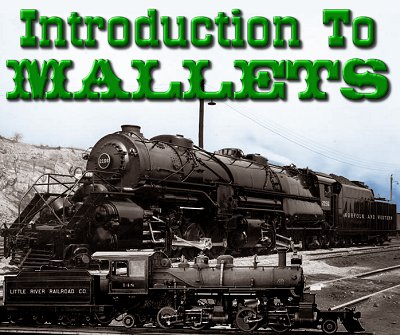 | |||
 |
 |
 | |
 |
 | ||
 |
 | ||
 |  | ||
 |  | ||
 | |||
 |
 |
 | |
 |
 | ||
 |
 | ||
 |  | ||
 |  | ||
| Published by Family Garden Trains and South East Pennsylvania Garden Railway Society |   |


|
Note from Editor: The core of this article appeared in the South Eastern Pennsylvania Garden Railway Society newsletter in August, 2004. I have some other articles about locomotives to post, but this one seemed timely in light of recent Large Scale and On30 articulated locomotive offerings by Bachmann. Uncharacteristically, the fellow who was editing the newsletter at that time did not keep a record of who actually wrote the article. So if you know who actually wrote this article, please let me know, so I can ask permission (belatedly) and give credit where it is due. Introduction to MalletsDesigned by the locomotive engineer and inventor Anatole Mallet (1837-1919), a Mallet-type locomotive is a four- cylinder, compound articulated locomotive. Mallet locomotives have essentially two steam engines mounted under the same boiler. The rear engine is rigidly attached to the boiler, while the front engine is able to swing laterally around a pivot point located near the rear, high-pressure cylinders (see Figure 1 below). This articulation allows the locomotives to negotiate curves that would not accommodate a large rigid-frame locomotive.
Compound MalletsOn a compound Mallet, live steam from the boiler powers the rear cylinders. Then the exhaust from the rear cylinders powers the forward low-pressure cylinders (see Figure 2 below). To compensate for the lower temperature and pressure of the exhaust steam, the low-pressure cylinders are much larger in diameter that the rear set.
This compounding system allows for savings on fuel and water, however the difficulties in setting valves to deal with the volume of low pressure steam, and the slow speeds of compound Mallets led to most American railroads abandoning compounds by the 1920s. Exceptions to this were such locomotives as Norfolk & Western’s famous Y-class 2-8-8-2s, which were still being built as compounds into the 1950s, and of course the logging Mallets, of which all but six were compounds. What distinguishes this locomotive from other large steam engines is that not only are there 4 cylinders and four sets of driving wheels, but also that the steam is used twice, first by the high pressure cylinders, then by the low pressure cylinders. The result is an engine with great pulling power, though not great speed, and moderate efficiency compared to a standard 4 cylinder engine. The LGB Uintah Mallet is not a true Mallet. This is because it has 4 equal-sized cylinders, and the steam to each is used just once before being exhausted up the stack. It is articulated, meaning that the front drivers can pivot for following winding tracks, but it is not a Mallet. Pop QuizThink you have all the Mallet answers? Test your knowledge by answering the questions below. You can find the answers toward the end of this article.Do you know...?
For More InformationTwo early descriptions of the science of Mallet locomotives may be helpful:
Example Models of Articulated LocomotivesHO and N have had many mallet models for decades, including Big Boys, and 2-8-8-2s patterned after the N&W Y6B engines. But since my pages serve mostly O scale and larger modelers, here are some articlulated models worth your consideration. They're not all technically Mallets, and some of them can be hard to come by, as they come in and out of production. But they're all really big fun.Large Scale (Garden Train) Articulateds - Narrow GaugeThe following three locomotives are available in scales running from 1:20.3 to 1:22.5, suitable for modeling narrow gauge industrial or short-line railroads outdoors.
Large Scale (Garden Train) Articulateds - Standard GaugeThe following locomotives represent several "common carrier" mainline locomotives that kept up regular operations as late as 1960 on major railroads across the country. They range from 1:29 to 1:32 in scale and are suitable for modeling really big railroads. Hope you have room for really big curves. 10'-diameter curves are the minum, but they all look better on 15'- or 20'-diameter curves.
On30 Articulateds
Note: Several of the Bachmann On30 articulated locomotives are currently being offered at discount by vendors at Amazon. I have provided links near the bottom of this page. O Gauge Articulateds
Answers to Mallet questions: (1) UP Big Boy (2) DM&IR Yellowstone (3) UP Big Boy (4) UP Big Boy (5) C&O H8 Allegheny (6) Counting all old dogs Virginian Triplex, 2-8-8-8-4 (7) NW Y6b (8) UP Challenger (9) NW surplus Y3s wandered around because of WWII. (10) Virginian Triplex, 2-8-8-8-4 (11) PRR Q1, Q2, S1 & T1 New On30 ModelsThe following Amazon links take you to some of the Bachmann On30 2-6-6-2 models to help you see what variety is available.
|
|

| 
|
 |
 |
 |
 |
 |
Note: Family Garden TrainsTM, Garden Train StoreTM, Big Christmas TrainsTM, BIG Indoor TrainsTM, and BIG Train StoreTM are trademarks of Breakthrough Communications (www.btcomm.com). All information, data, text, and illustrations on this web site are Copyright (c) 1999, 2000, 2001, 2002, 2003, 2004, 2005, 2006, 2007, 2008, 2009, 2010, 2011, 2012, 2013 by Paul D. Race. Reuse or republication without prior written permission is specifically
forbidden.
Family Garden Trains is a participant in the Amazon Services LLC Associates Program, an affiliate advertising program designed to provide a means for sites to earn advertising fees by advertising and linking to amazon.com.
For more information, please contact us

 |  |